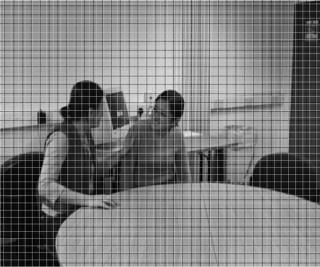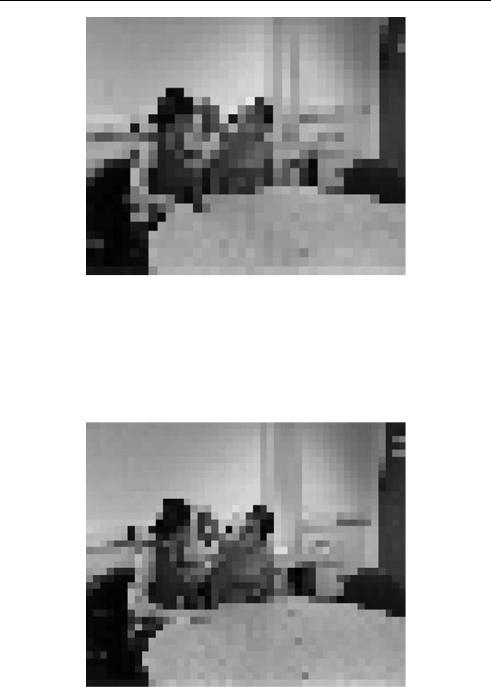
- •Copyright
- •Contents
- •About the Author
- •Foreword
- •Preface
- •Glossary
- •1 Introduction
- •1.1 THE SCENE
- •1.2 VIDEO COMPRESSION
- •1.4 THIS BOOK
- •1.5 REFERENCES
- •2 Video Formats and Quality
- •2.1 INTRODUCTION
- •2.2 NATURAL VIDEO SCENES
- •2.3 CAPTURE
- •2.3.1 Spatial Sampling
- •2.3.2 Temporal Sampling
- •2.3.3 Frames and Fields
- •2.4 COLOUR SPACES
- •2.4.2 YCbCr
- •2.4.3 YCbCr Sampling Formats
- •2.5 VIDEO FORMATS
- •2.6 QUALITY
- •2.6.1 Subjective Quality Measurement
- •2.6.2 Objective Quality Measurement
- •2.7 CONCLUSIONS
- •2.8 REFERENCES
- •3 Video Coding Concepts
- •3.1 INTRODUCTION
- •3.2 VIDEO CODEC
- •3.3 TEMPORAL MODEL
- •3.3.1 Prediction from the Previous Video Frame
- •3.3.2 Changes due to Motion
- •3.3.4 Motion Compensated Prediction of a Macroblock
- •3.3.5 Motion Compensation Block Size
- •3.4 IMAGE MODEL
- •3.4.1 Predictive Image Coding
- •3.4.2 Transform Coding
- •3.4.3 Quantisation
- •3.4.4 Reordering and Zero Encoding
- •3.5 ENTROPY CODER
- •3.5.1 Predictive Coding
- •3.5.3 Arithmetic Coding
- •3.7 CONCLUSIONS
- •3.8 REFERENCES
- •4 The MPEG-4 and H.264 Standards
- •4.1 INTRODUCTION
- •4.2 DEVELOPING THE STANDARDS
- •4.2.1 ISO MPEG
- •4.2.4 Development History
- •4.2.5 Deciding the Content of the Standards
- •4.3 USING THE STANDARDS
- •4.3.1 What the Standards Cover
- •4.3.2 Decoding the Standards
- •4.3.3 Conforming to the Standards
- •4.7 RELATED STANDARDS
- •4.7.1 JPEG and JPEG2000
- •4.8 CONCLUSIONS
- •4.9 REFERENCES
- •5 MPEG-4 Visual
- •5.1 INTRODUCTION
- •5.2.1 Features
- •5.2.3 Video Objects
- •5.3 CODING RECTANGULAR FRAMES
- •5.3.1 Input and output video format
- •5.5 SCALABLE VIDEO CODING
- •5.5.1 Spatial Scalability
- •5.5.2 Temporal Scalability
- •5.5.3 Fine Granular Scalability
- •5.6 TEXTURE CODING
- •5.8 CODING SYNTHETIC VISUAL SCENES
- •5.8.1 Animated 2D and 3D Mesh Coding
- •5.8.2 Face and Body Animation
- •5.9 CONCLUSIONS
- •5.10 REFERENCES
- •6.1 INTRODUCTION
- •6.1.1 Terminology
- •6.3.2 Video Format
- •6.3.3 Coded Data Format
- •6.3.4 Reference Pictures
- •6.3.5 Slices
- •6.3.6 Macroblocks
- •6.4 THE BASELINE PROFILE
- •6.4.1 Overview
- •6.4.2 Reference Picture Management
- •6.4.3 Slices
- •6.4.4 Macroblock Prediction
- •6.4.5 Inter Prediction
- •6.4.6 Intra Prediction
- •6.4.7 Deblocking Filter
- •6.4.8 Transform and Quantisation
- •6.4.11 The Complete Transform, Quantisation, Rescaling and Inverse Transform Process
- •6.4.12 Reordering
- •6.4.13 Entropy Coding
- •6.5 THE MAIN PROFILE
- •6.5.1 B slices
- •6.5.2 Weighted Prediction
- •6.5.3 Interlaced Video
- •6.6 THE EXTENDED PROFILE
- •6.6.1 SP and SI slices
- •6.6.2 Data Partitioned Slices
- •6.8 CONCLUSIONS
- •6.9 REFERENCES
- •7 Design and Performance
- •7.1 INTRODUCTION
- •7.2 FUNCTIONAL DESIGN
- •7.2.1 Segmentation
- •7.2.2 Motion Estimation
- •7.2.4 Wavelet Transform
- •7.2.6 Entropy Coding
- •7.3 INPUT AND OUTPUT
- •7.3.1 Interfacing
- •7.4 PERFORMANCE
- •7.4.1 Criteria
- •7.4.2 Subjective Performance
- •7.4.4 Computational Performance
- •7.4.5 Performance Optimisation
- •7.5 RATE CONTROL
- •7.6 TRANSPORT AND STORAGE
- •7.6.1 Transport Mechanisms
- •7.6.2 File Formats
- •7.6.3 Coding and Transport Issues
- •7.7 CONCLUSIONS
- •7.8 REFERENCES
- •8 Applications and Directions
- •8.1 INTRODUCTION
- •8.2 APPLICATIONS
- •8.3 PLATFORMS
- •8.4 CHOOSING A CODEC
- •8.5 COMMERCIAL ISSUES
- •8.5.1 Open Standards?
- •8.5.3 Capturing the Market
- •8.6 FUTURE DIRECTIONS
- •8.7 CONCLUSIONS
- •8.8 REFERENCES
- •Bibliography
- •Index

• |
VIDEO FORMATS AND QUALITY |
10 |
Figure 2.1 Still image from natural video scene
.. . |
. .. |
. |
|
||
|
|
|
|
|
|
|
s |
|
|
|
|
ple |
|
|
|
|
am |
|
|
|
|
l s |
|
|
|
|
tia |
|
|
|
|
pa |
|
|
|
|
|
S |
|
|
|
|
|
Temporal samples
Figure 2.2 Spatial and temporal sampling of a video sequence
2.3 CAPTURE
A natural visual scene is spatially and temporally continuous. Representing a visual scene in digital form involves sampling the real scene spatially (usually on a rectangular grid in the video image plane) and temporally (as a series of still frames or components of frames sampled at regular intervals in time) (Figure 2.2). Digital video is the representation of a sampled video scene in digital form. Each spatio-temporal sample (picture element or pixel) is represented as a number or set of numbers that describes the brightness (luminance) and colour of the sample.

CAPTURE |
• |
|
11 |
|
|
Figure 2.3 Image with 2 sampling grids
To obtain a 2D sampled image, a camera focuses a 2D projection of the video scene onto a sensor, such as an array of Charge Coupled Devices (CCD array). In the case of colour image capture, each colour component is separately filtered and projected onto a CCD array (see Section 2.4).
2.3.1 Spatial Sampling
The output of a CCD array is an analogue video signal, a varying electrical signal that represents a video image. Sampling the signal at a point in time produces a sampled image or frame that has defined values at a set of sampling points. The most common format for a sampled image is a rectangle with the sampling points positioned on a square or rectangular grid. Figure 2.3 shows a continuous-tone frame with two different sampling grids superimposed upon it. Sampling occurs at each of the intersection points on the grid and the sampled image may be reconstructed by representing each sample as a square picture element (pixel). The visual quality of the image is influenced by the number of sampling points. Choosing a ‘coarse’ sampling grid (the black grid in Figure 2.3) produces a low-resolution sampled image (Figure 2.4) whilst increasing the number of sampling points slightly (the grey grid in Figure 2.3) increases the resolution of the sampled image (Figure 2.5).
2.3.2 Temporal Sampling
A moving video image is captured by taking a rectangular ‘snapshot’ of the signal at periodic time intervals. Playing back the series of frames produces the appearance of motion. A higher temporal sampling rate (frame rate) gives apparently smoother motion in the video scene but requires more samples to be captured and stored. Frame rates below 10 frames per second are sometimes used for very low bit-rate video communications (because the amount of data

• |
VIDEO FORMATS AND QUALITY |
12 |
Figure 2.4 Image sampled at coarse resolution (black sampling grid)
Figure 2.5 Image sampled at slightly finer resolution (grey sampling grid)
